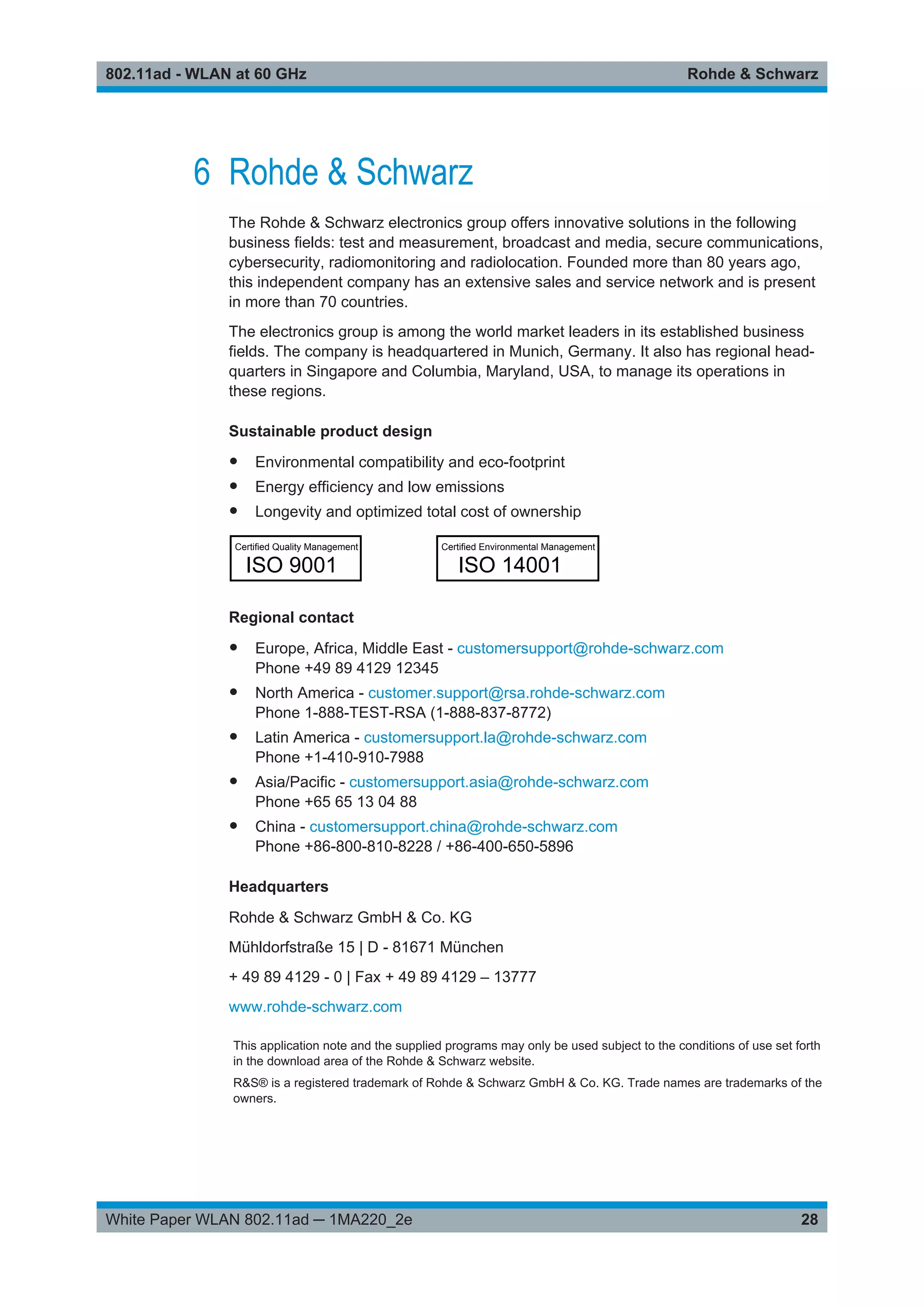802.11ad defines WLAN standards for the 60GHz frequency band, allowing wireless data transmission rates of up to 7Gbps. It uses three different physical layer modes: single carrier, which provides data rates from 385Mbps to 4.6Gbps; OFDM, which supports up to 7Gbps; and a control mode for signaling. Key features include high throughput enabled by the wide 60GHz spectrum and use of beamforming to direct signals. The document provides details on modulation schemes, packet structures, and other technical aspects of the 3 PHY modes.
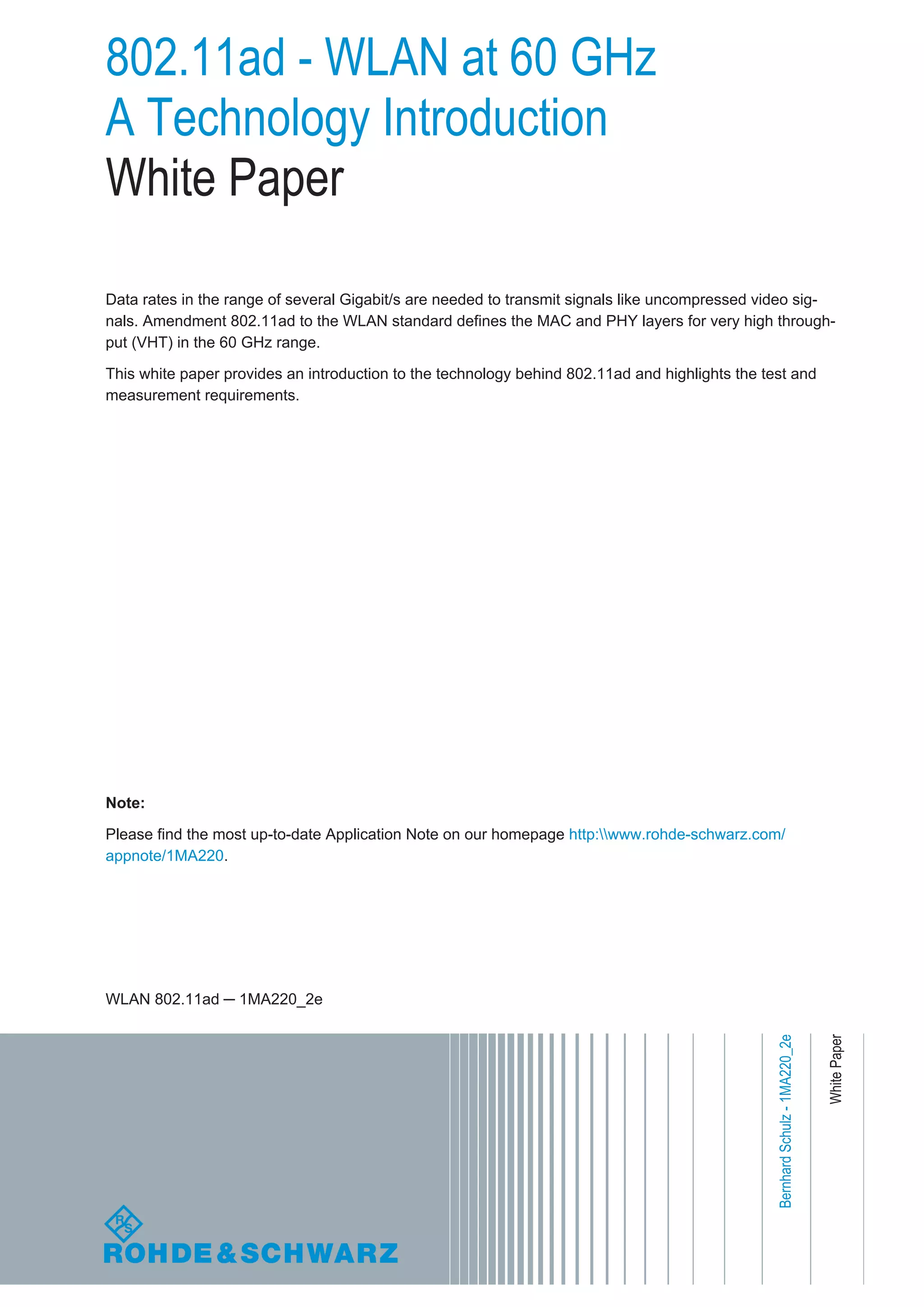
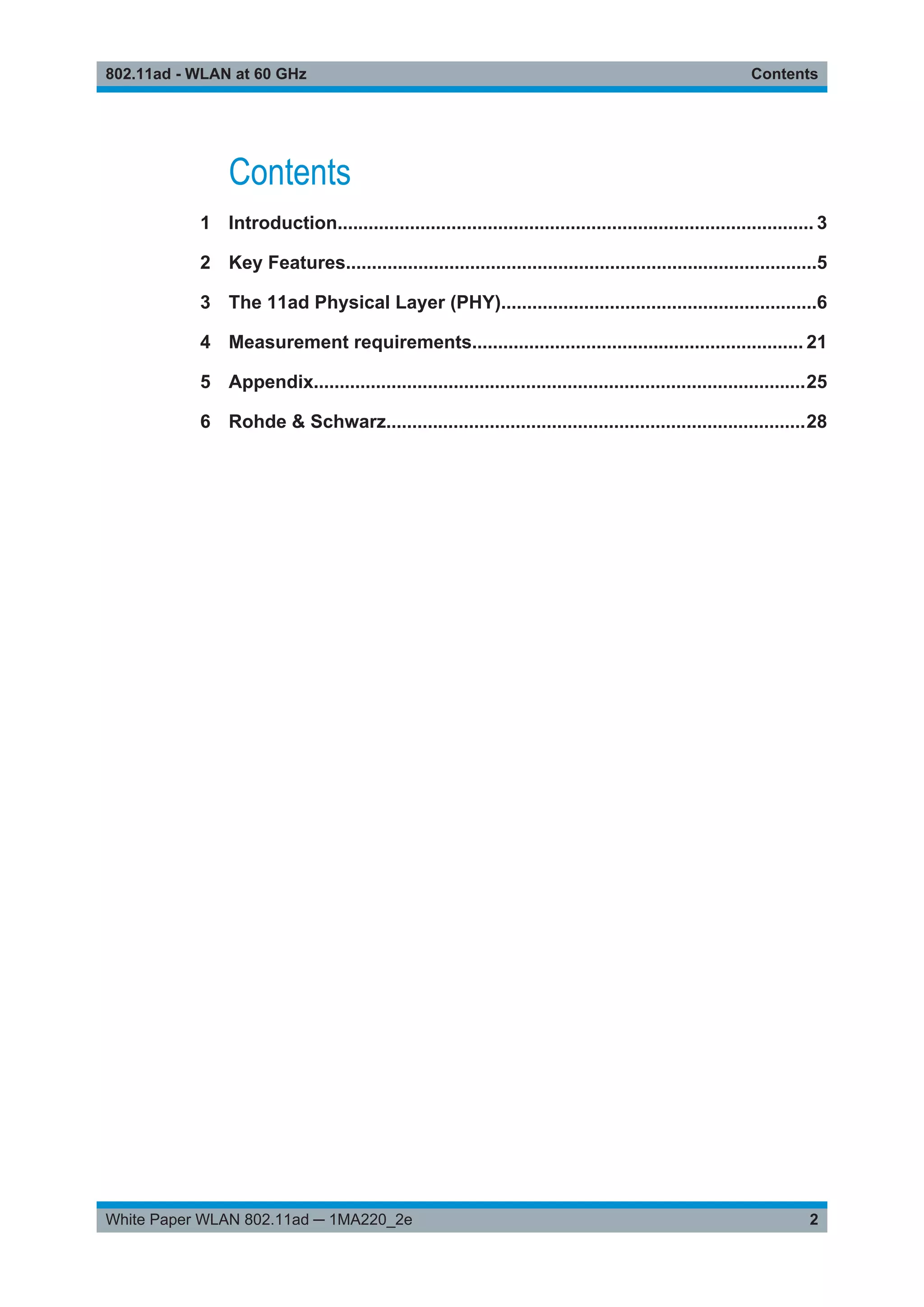
![Introduction802.11ad - WLAN at 60 GHz
3White Paper WLAN 802.11ad ─ 1MA220_2e
1 Introduction
Digital wireless communications will always demand more throughput than is available.
Especially when several users must share the same physical resources, only a fraction
of the nominal throughput remains. Multimedia data streams in particular require very
high throughput on a continuous basis. One example is uncoded 3D high definition
video streams (currently at 4k resolution (Ultra-HD: 3840 x 2160 pixels), and the trend
is toward higher frame rates of e.g. 48 frames per second).
To meet this need, the Wireless Gigabit Alliance (WiGig) has developed a specification
for wireless transmission of data in the 60 GHz band at speeds in the multi-Gigabit
range.
Why the 60 GHz band?
In the range around 60 GHz, an unlicensed frequency band is available everywhere in
the world. This range permits higher channel bandwidths for greater throughput.
Another advantage is the small wavelengths (approx. 5 mm). These make it possible to
use compact and competitive antennas or antenna arrays (e.g. for beamforming).
At first glance, however, this range also has some apparent disadvantages:
● very high free field attenuation in this band. (attenuation after 1 m: 68 dB, after 10
m: 91 dB)
● oxygen (O2) absorption
However, because the transmission typically takes place within a limited range of
under 10 m (the typical living room), the high degree of attenuation can also be seen
as an advantage. Interference from adjacent transmissions is very unlikely. The trans-
mission is very difficult to intercept, making it even more secure. Finally, beamforming
can be used to focus the power to the receiver.
WLAN 802.11
The 802.11 WLAN standard has also been continuously updated to permit higher
throughput. These changes were developed as amendments, but have since been
assigned their own letter as enhancements to the standard using the MAC and PHY
layers. The relevant standard enhancements are 11a,b,g,n and these cover the two
bands in the 2.4 GHz and the 5 GHz range. The 11n extension (also called High
Throughput (HT)) uses up to four MIMO streams to achieve a data rate of up to 600
Mbit/s. The 11p standard is an extension that permits robust data traffic between auto-
mobiles (car to car).
You can read more about the various standards in The WLAN Universe [3]. For T&M
possibilities using Rohde & Schwarz instruments, refer to
● http:www.rohde-schwarz.com/appnote/1MA169
● http:www.rohde-schwarz.com/appnote/1MA179
● http:www.rohde-schwarz.com/appnote/1EF82
● http:www.rohde-schwarz.com/appnote/1MA152](https://image.slidesharecdn.com/1ma2202ewlan11adwp-170705105615/75/WLAN-at-60GHz-Whitepaper-from-R-S-1-ma220-2e_wlan_11ad_wp-3-2048.jpg)

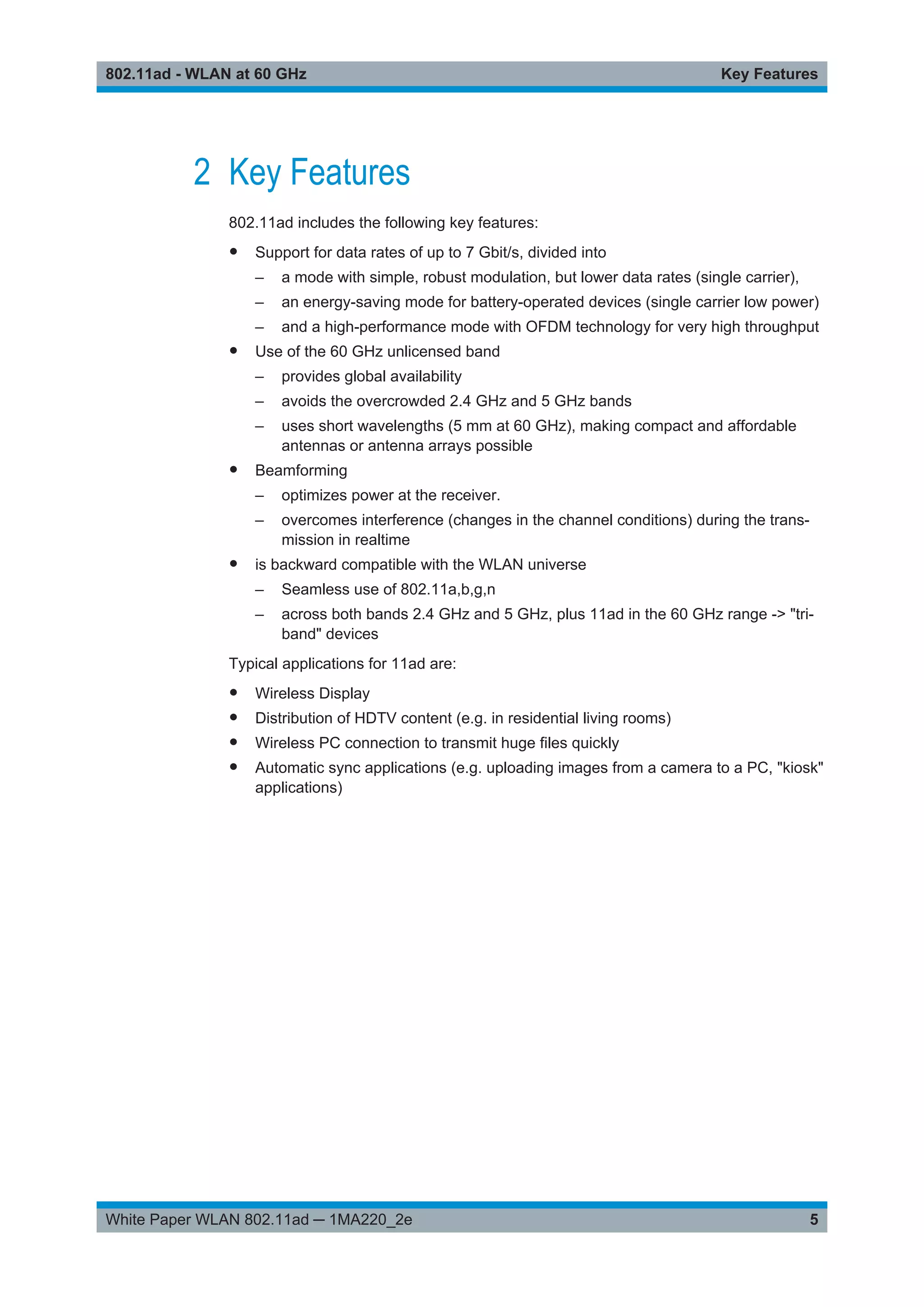
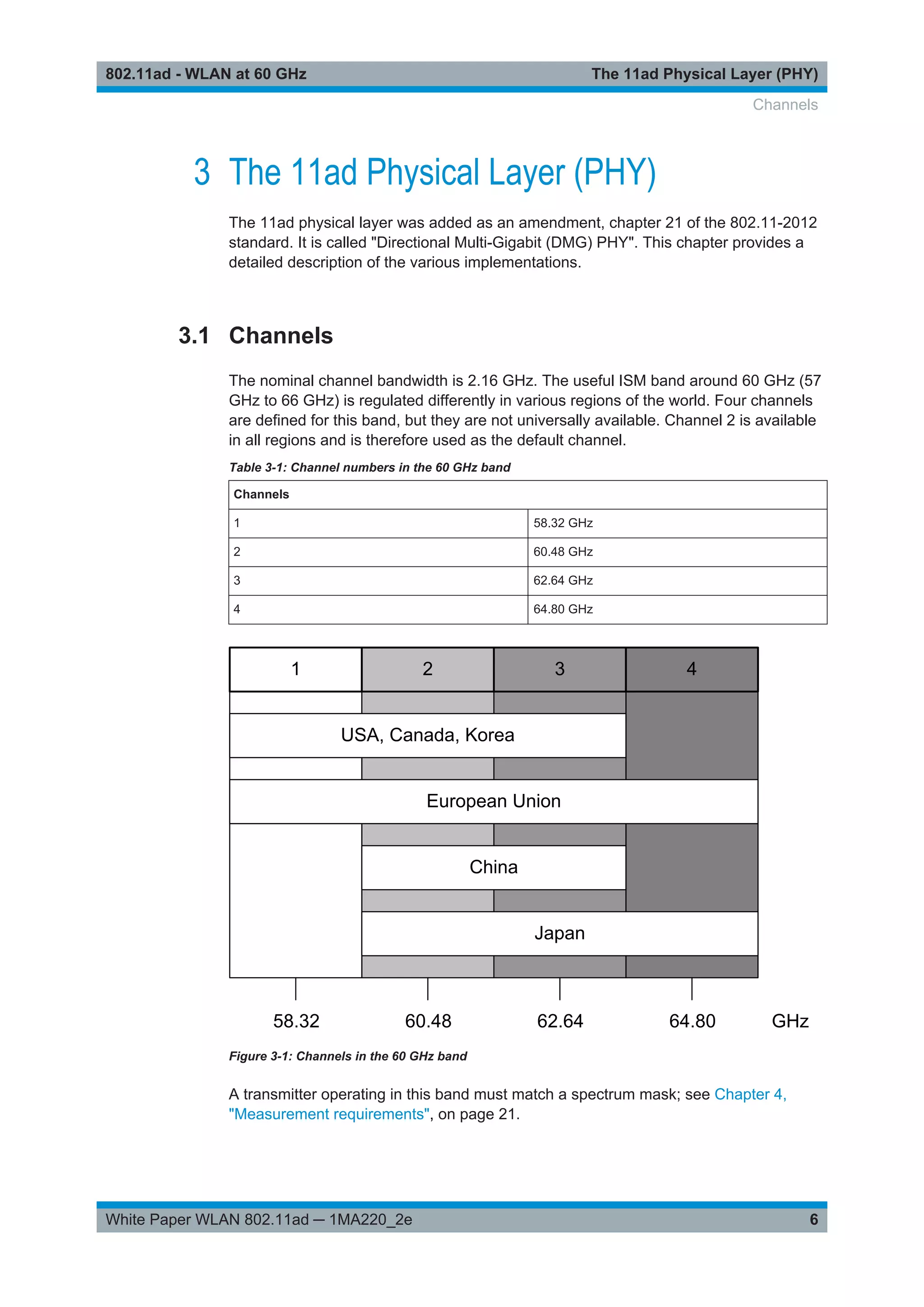
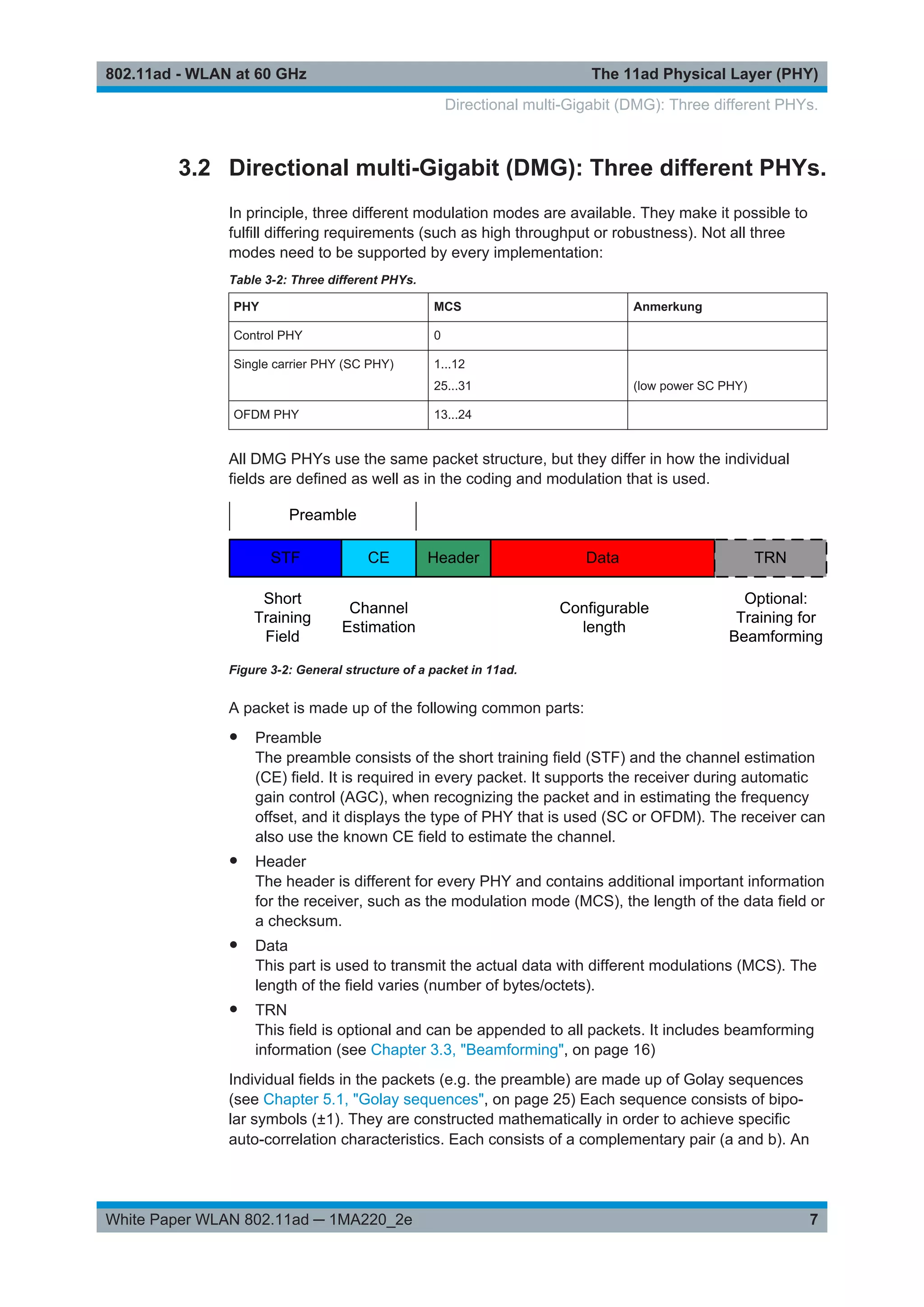
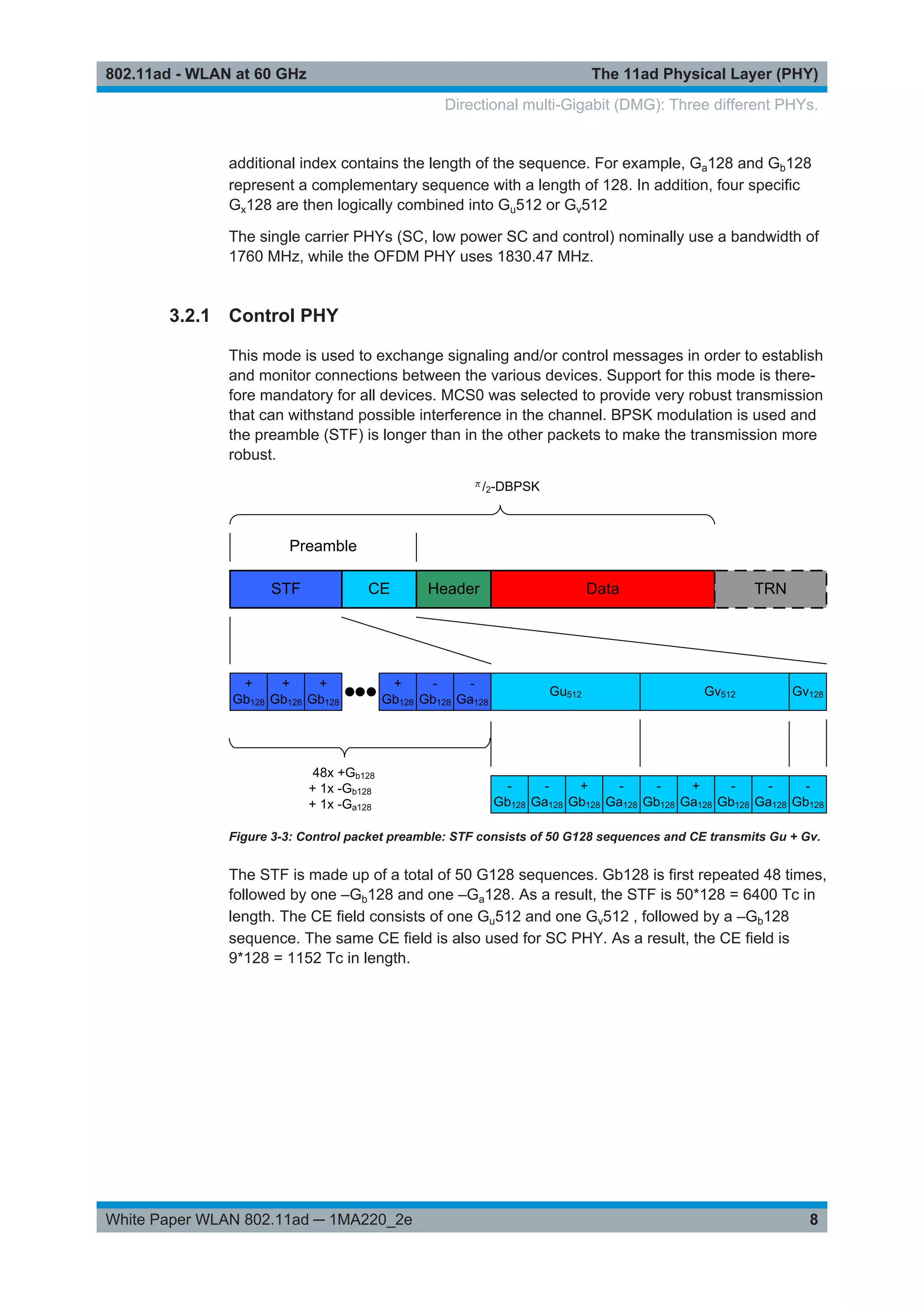
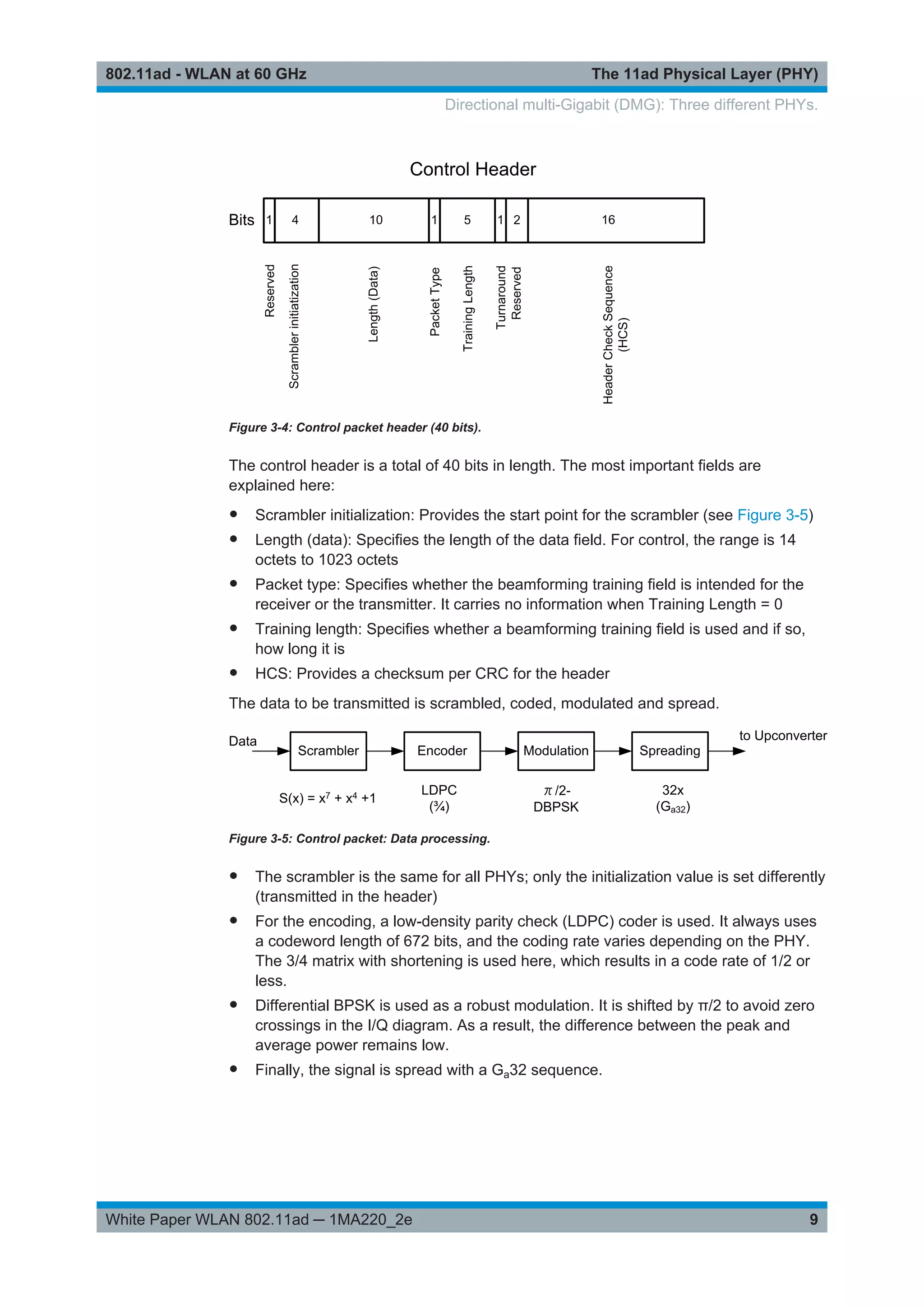
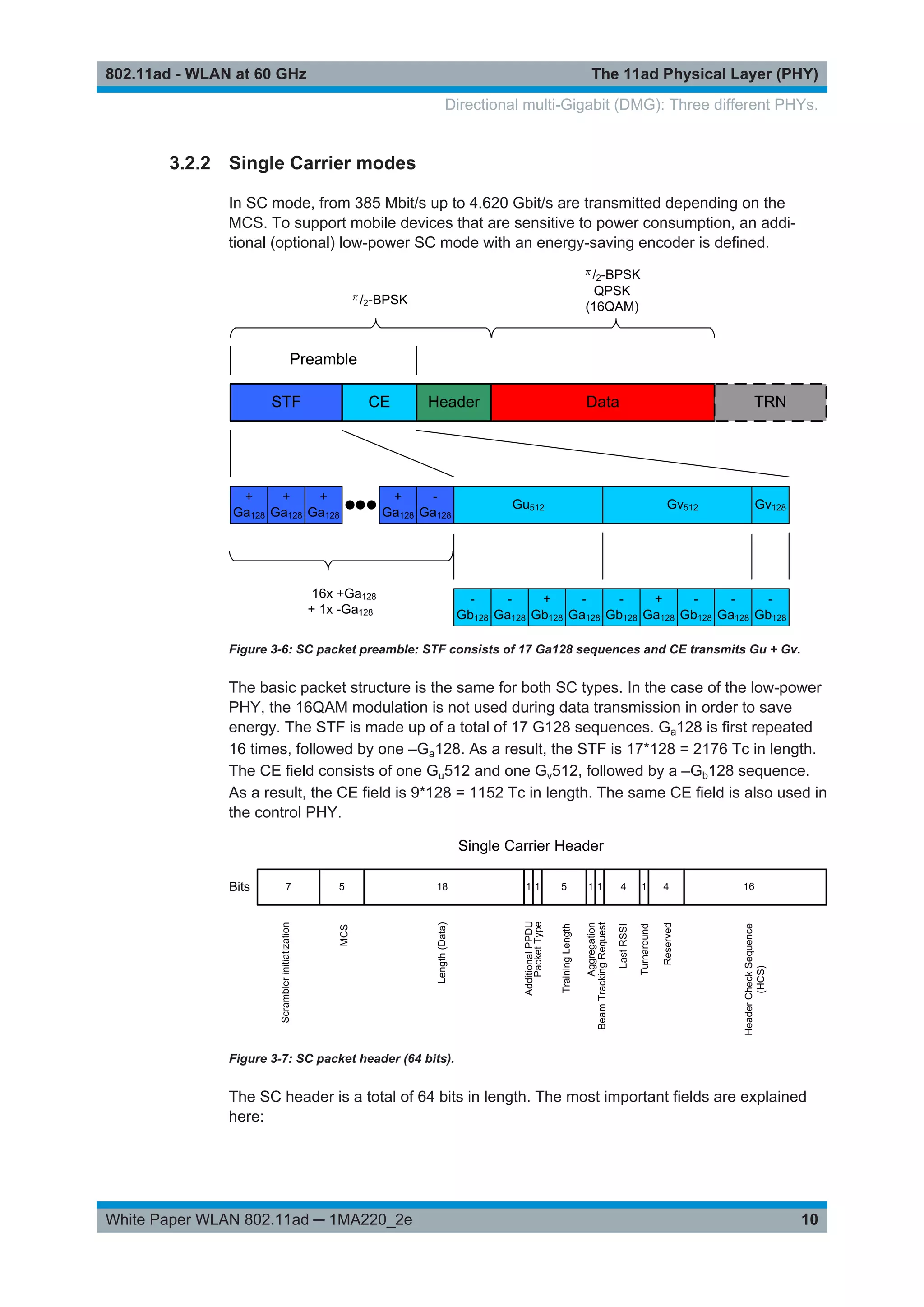
![The 11ad Physical Layer (PHY)802.11ad - WLAN at 60 GHz
11White Paper WLAN 802.11ad ─ 1MA220_2e
● Scrambler initialization: Provides the start point for the scrambler (see Figure 3-5)
● MCS: Displays the modulation and coding scheme used in the data field
● Length (data): Specifies the length of the data field. For control, the range is 1 octet
to 262143 octets
● Packet type: Specifies whether the beamforming training field is intended for the
receiver or the transmitter. It carries no information when Training Length = 0
● Training length: Specifies whether a beamforming training field is used and if so,
how long it is
● Last RSSI: Displays the power level of the last field received
● HCS: Provides a checksum per CRC for the header
The additional steps for the data field differ for SC PHY and for low-power SC PHY.
3.2.2.1 SC PHY
This method is the simplest transmission option. A total of 12 MCS (1 to 12) are
defined, whereby support for MCS 1 to 4 is mandatory. The various MCS have differ-
ent modulations and code rates, and therefore also different throughputs. MCS1
(BPSK and code rate 1/2) can achieve 385 Mbit/s, MCS4 (BPSK and code rate 3/4) up
to 1.115 Gbit/s and MCS12 (16QAM and code rate 3/4) up to 4.620 Gbit/s. A complete
table of MCS1 to 12 for SC PHY is available at [1 - Table 21-18].
The data to be transmitted is scrambled, coded, modulated and blockwise transmitted.
Figure 3-8: SC PHY packet: Data processing.
● The scrambler is the same for all PHYs; only the initialization value is set differently
(transmitted in the header)
● A low-density parity check (LDPC) coder is used for the encoding. It always uses a
codeword length of 672 bits, and the coding rate varies depending on the PHY. In
this case, code rates 1/2, 5/8, 3/4 and 13/16 are used.
● Depending on the data rate, various types of modulation are used (BPSK, QPSK or
16QAM). Each is shifted by π/2 to avoid zero crossings in the I/Q diagram. As a
result, the difference between the peak and average power remains low.
● The data are transmitted blockwise at 448 symbols per block. Another 64 symbols
are inserted between the individual blocks as guard intervals (GI) in order to pro-
vide a known reference signal to the receiver in the case of long data packets. The
complete block is therefore 512 (448 + 64) symbols in length. The GI consists of a
Ga64 Golay sequence and is always modulated with π/2-BPSK.
Directional multi-Gigabit (DMG): Three different PHYs.](https://image.slidesharecdn.com/1ma2202ewlan11adwp-170705105615/75/WLAN-at-60GHz-Whitepaper-from-R-S-1-ma220-2e_wlan_11ad_wp-11-2048.jpg)
![The 11ad Physical Layer (PHY)802.11ad - WLAN at 60 GHz
12White Paper WLAN 802.11ad ─ 1MA220_2e
Figure 3-9: SC PHY data blocks: A data block is made up of 512 symbols (64 GI + 448 data).
3.2.2.2 Low power SC PHY
This method is set up similarly to the SC PHY, but it is optimized to save energy in
order to support small, battery-operated devices as well. In contrast to all other PHYs,
the LDPC is replaced by an energy-saving alternative, and unlike SC PHY, 16QAM
modulation is not used. A total of seven MCS (25 to 31) are defined, and all are
optional. The various MCS have different modulations and code rates, and therefore
also different throughputs. MCS25 (BPSK and code rate 13/28) permits rates of 626
Mbit/s to be achieved, and for MCS31 (QPSK and code rate 13/14) it is up to 2.503
Gbit/s. A complete table of MCS25 to 31 for low-power SC PHY is available at [1 -
Table 21-22].
The data to be transmitted is scrambled, coded, modulated and blockwise transmitted.
Figure 3-10: Low-power SC PHY packet: Data processing.
Directional multi-Gigabit (DMG): Three different PHYs.](https://image.slidesharecdn.com/1ma2202ewlan11adwp-170705105615/75/WLAN-at-60GHz-Whitepaper-from-R-S-1-ma220-2e_wlan_11ad_wp-12-2048.jpg)

![The 11ad Physical Layer (PHY)802.11ad - WLAN at 60 GHz
14White Paper WLAN 802.11ad ─ 1MA220_2e
A total of 12 MCS (13 to 24) are defined. The various MCS have different modulations
and code rates, and therefore also different throughputs. MCS13 (SQPSK and code
rate 1/2) permits rates of 693 Mbit/s to be achieved, and for MCS24 (64QAM and code
rate 13/16) it is up to the maximum possible rate of 6.757 Gbit/s. A complete table of
MCS13 to 24 for OFDM PHY is available at [1 - Table 21-14]. OFDM mode is optional,
but when it is implemented, MCS 13 to 17 must be supported.
Figure 3-12: OFDM packet preamble: STF consists of 17 Ga128 sequences and CE transmits Gv + Gu.
The basic packet structure is the same as the SC packet. However, to permit the
receiver to differentiate this packet from the SC packet, the sequence of Gu and Gv is
swapped in the CE field. The STF is made up of a total of 17 G128 sequences. Ga128
is first repeated 16 times, followed by one -Ga128. As a result, the STF is 17*128 =
2176 Tc in length. The CE field consists of one Gv512 and one Gu512, followed by a –
Gb128 sequence (the sequence of the SC-CE field is swapped). As a result, the CE
field is 9*128 = 1152 Tc in length.
Figure 3-13: OFDM header (64 bits).
Directional multi-Gigabit (DMG): Three different PHYs.](https://image.slidesharecdn.com/1ma2202ewlan11adwp-170705105615/75/WLAN-at-60GHz-Whitepaper-from-R-S-1-ma220-2e_wlan_11ad_wp-14-2048.jpg)
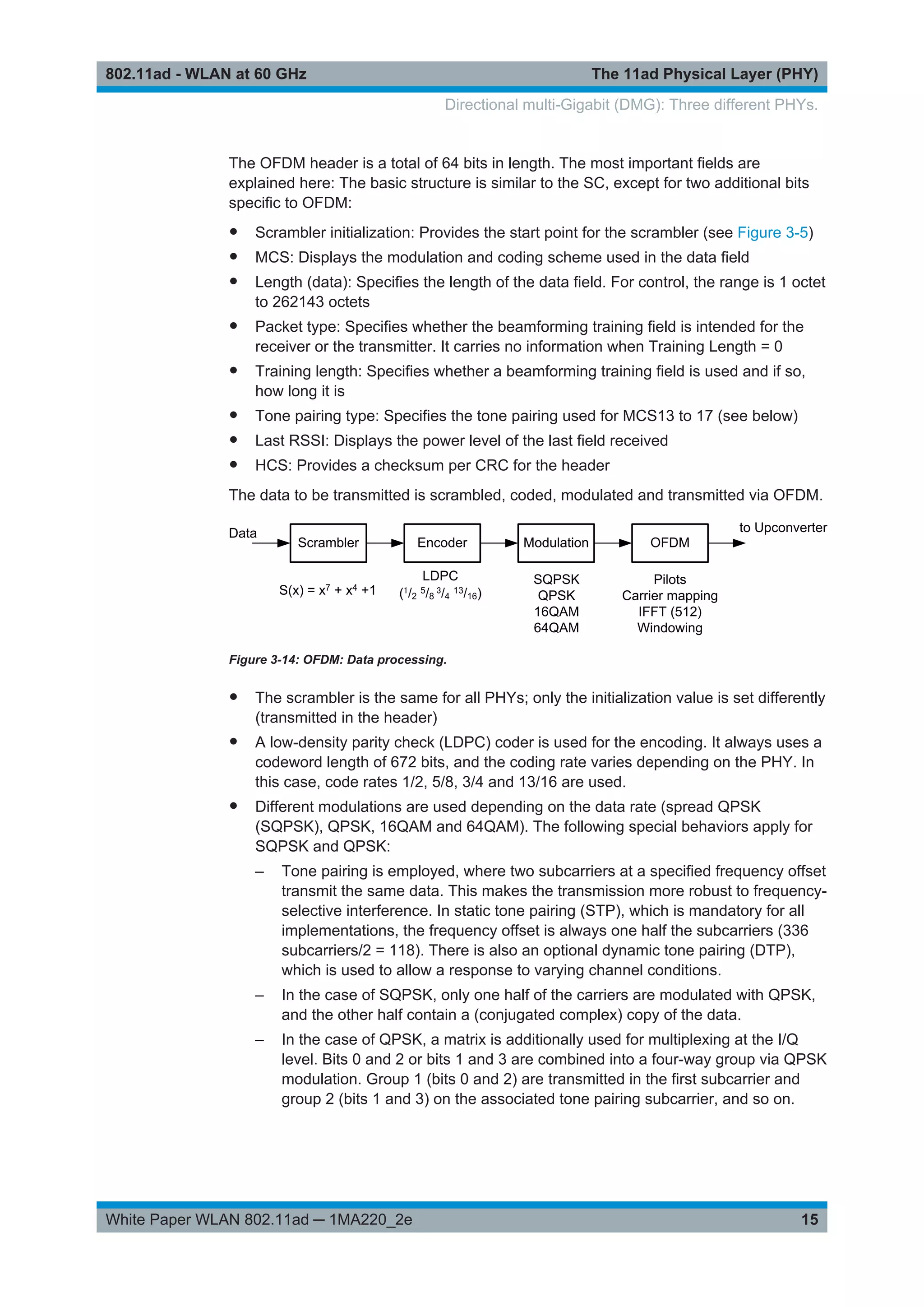
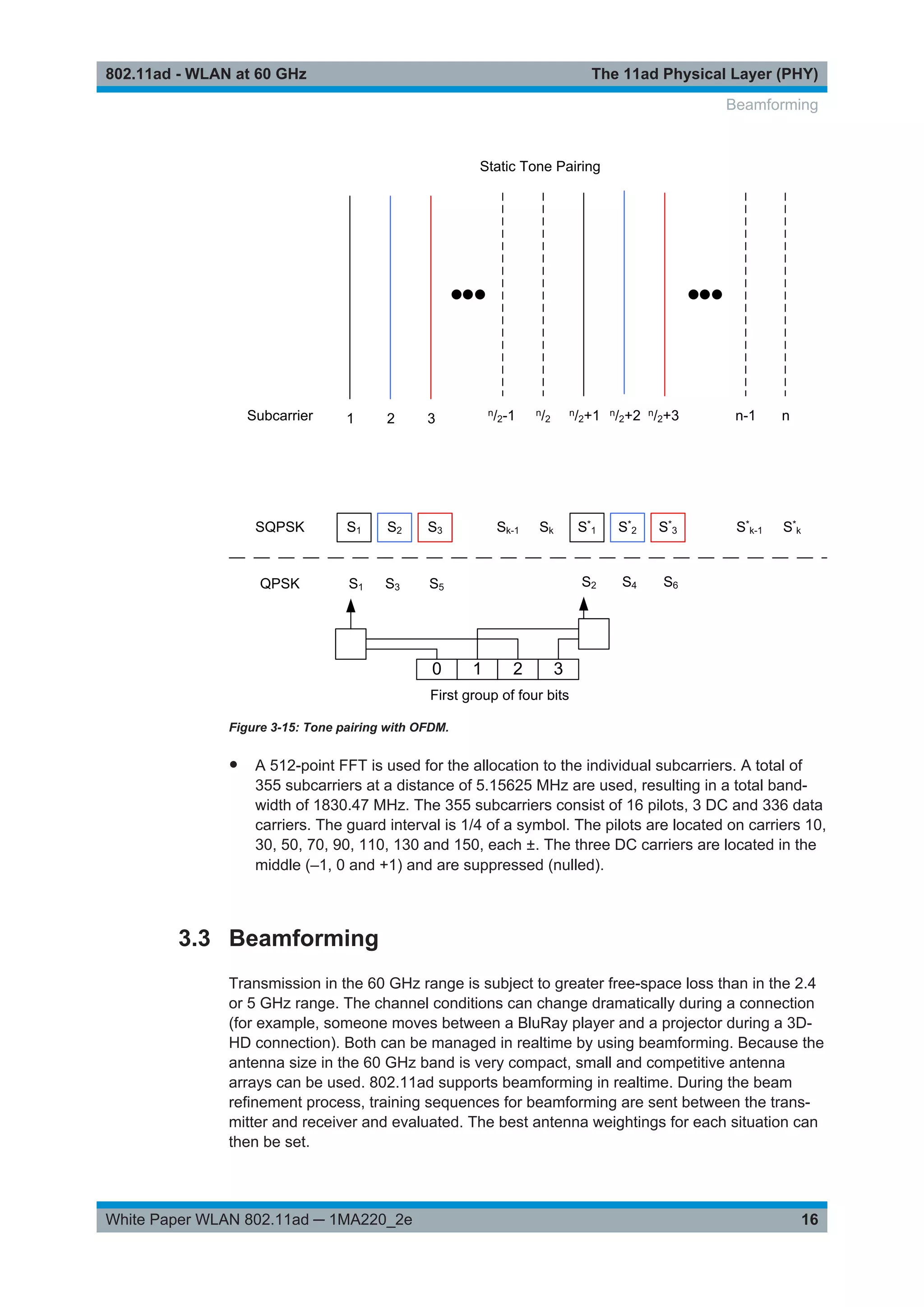
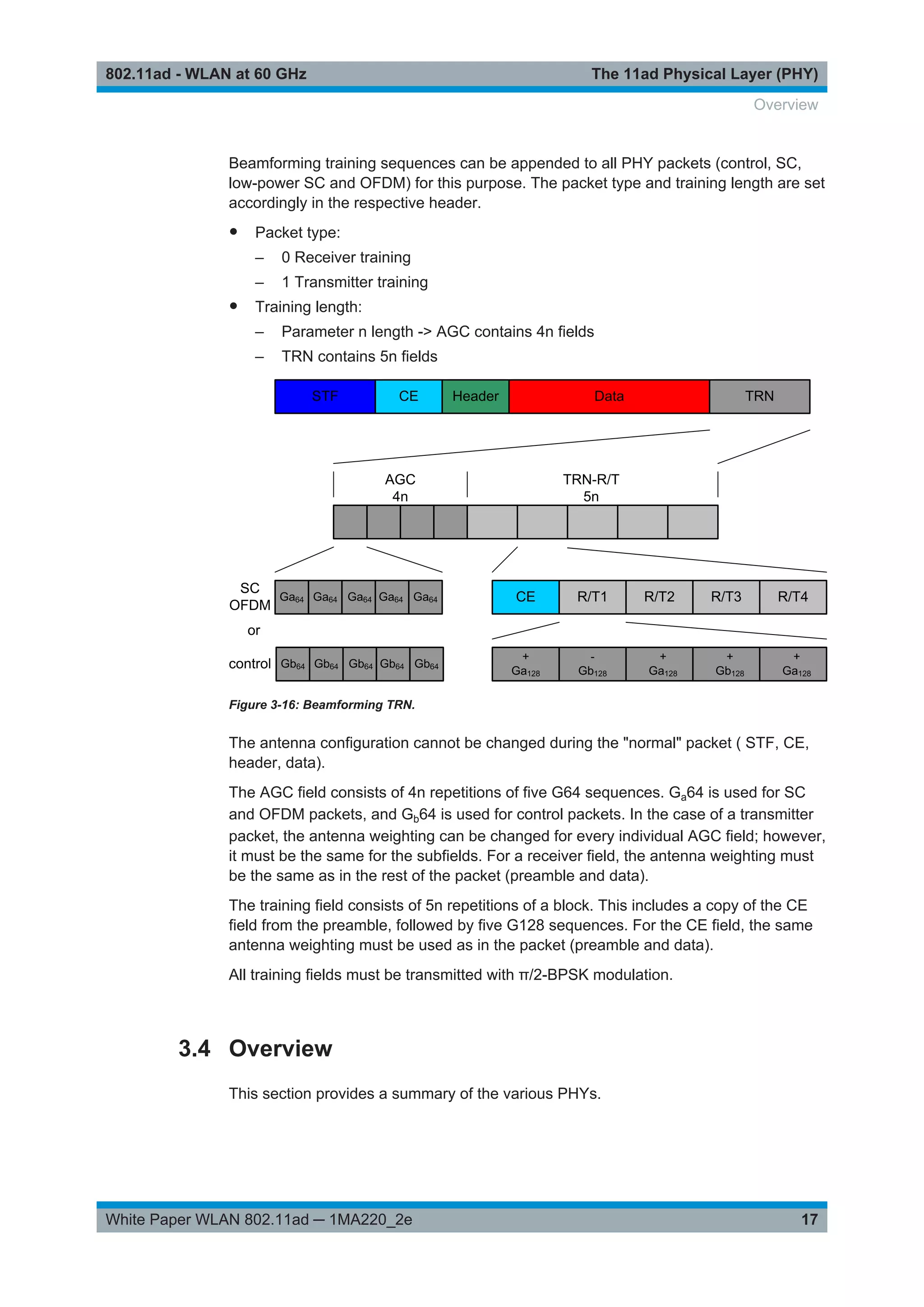

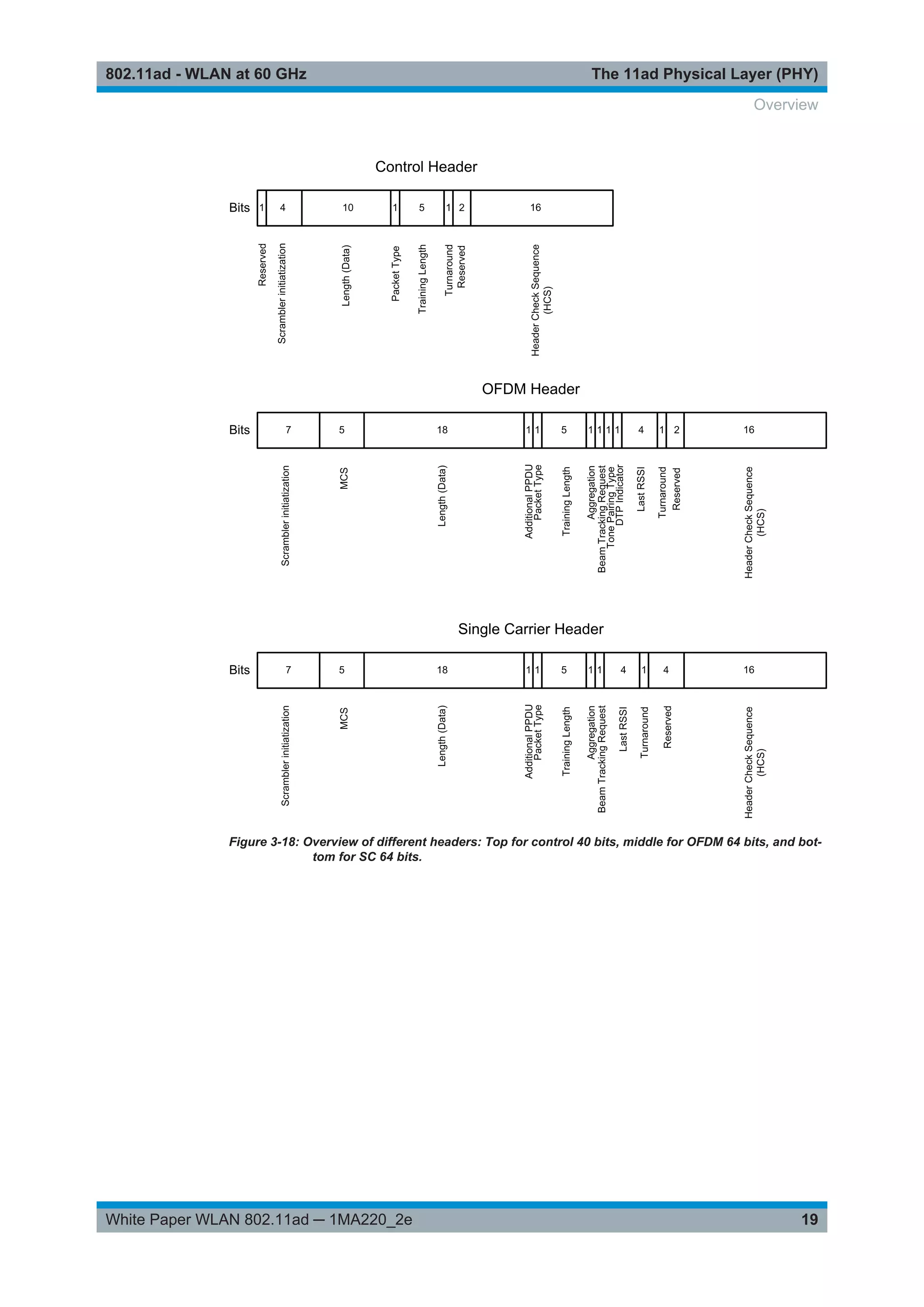
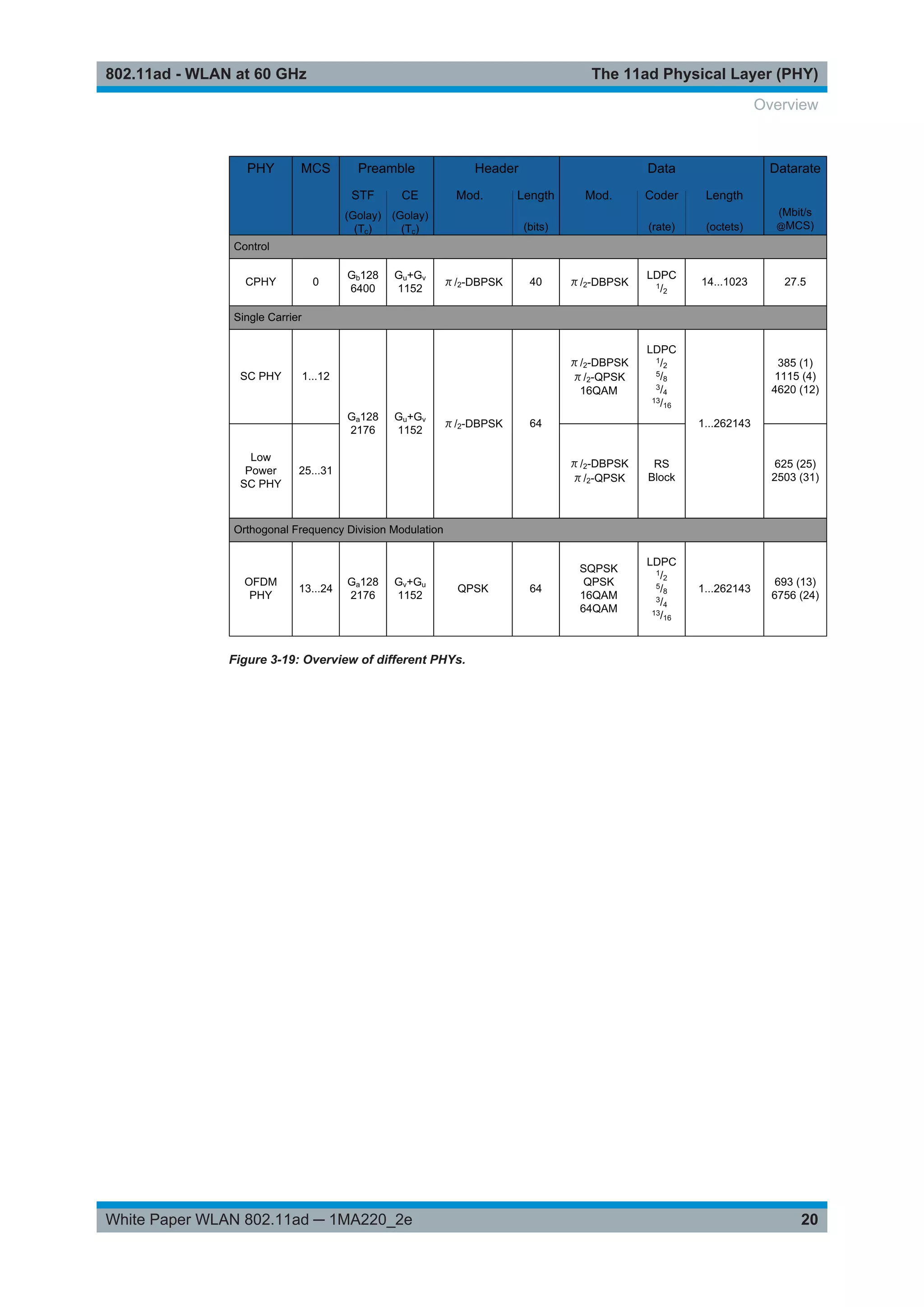
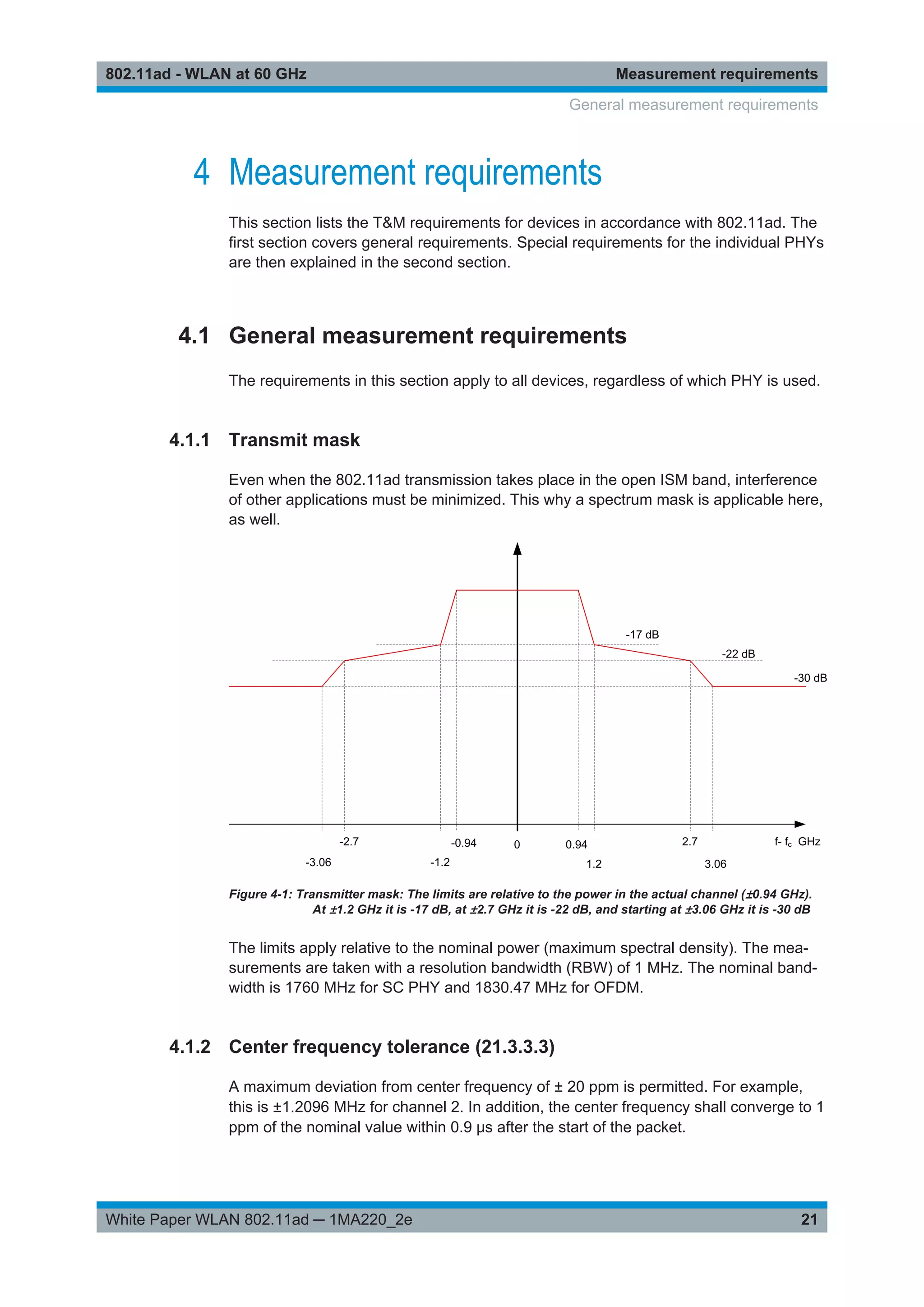
![Measurement requirements802.11ad - WLAN at 60 GHz
22White Paper WLAN 802.11ad ─ 1MA220_2e
4.1.3 Symbol clock tolerance (21.3.3.4)
The maximum of ± 20 ppm also applies for the symbol clock. Both the symbol clock
and the center frequency shall be derived from the same reference.
4.1.4 Transmit Center frequency leakage (21.3.3.5)
The center frequency leakage shall be less than –23 dB relative to the total power for
SC PHYs, or +2.5 dB relative to the power of a subcarrier for OFDM.
4.2 Transmit rampup and rampdown (21.3.3.6)
Both the ramp-up and the ramp-down times (10 % to 90 %) should be less than 10 ns.
4.3 Requirements dependent on PHY or MCS
Both the requirements for the transmit EVM (see [1], chapter 21.4.4.1.2, 21.5.4.1.2 and
21.6.4.1.1) and the receiver sensitivity (see [1] chapter 21.3.3.9 Table 21-3) depend on
the PHY and/or MCS. In the case of the low-power SC PHY, no limits are specified for
Tx EVM.
Table 4-1: Summary of the limits for transmit EVM and eceiver sensitivity.
MCS Transmit EVM
(dB)
Receiver Sen-
sitivity
(dBm)
CPHY 0 DPSK - 6 - 78
SC PHY 1 π/2-PSK - 6 - 68
2 - 7 - 66
3 - 9 - 64
4 - 10 - 64
5 - 12 - 62
6 π/2-QPSK - 11 - 63
7 - 12 - 62
8 - 13 - 61
9 - 15 - 59
10 π/2-16QAM - 19 - 55
11 - 20 - 54
12 - 21 - 53
OFDM PHY 13 SQPSK - 7 - 66
Requirements dependent on PHY or MCS](https://image.slidesharecdn.com/1ma2202ewlan11adwp-170705105615/75/WLAN-at-60GHz-Whitepaper-from-R-S-1-ma220-2e_wlan_11ad_wp-22-2048.jpg)
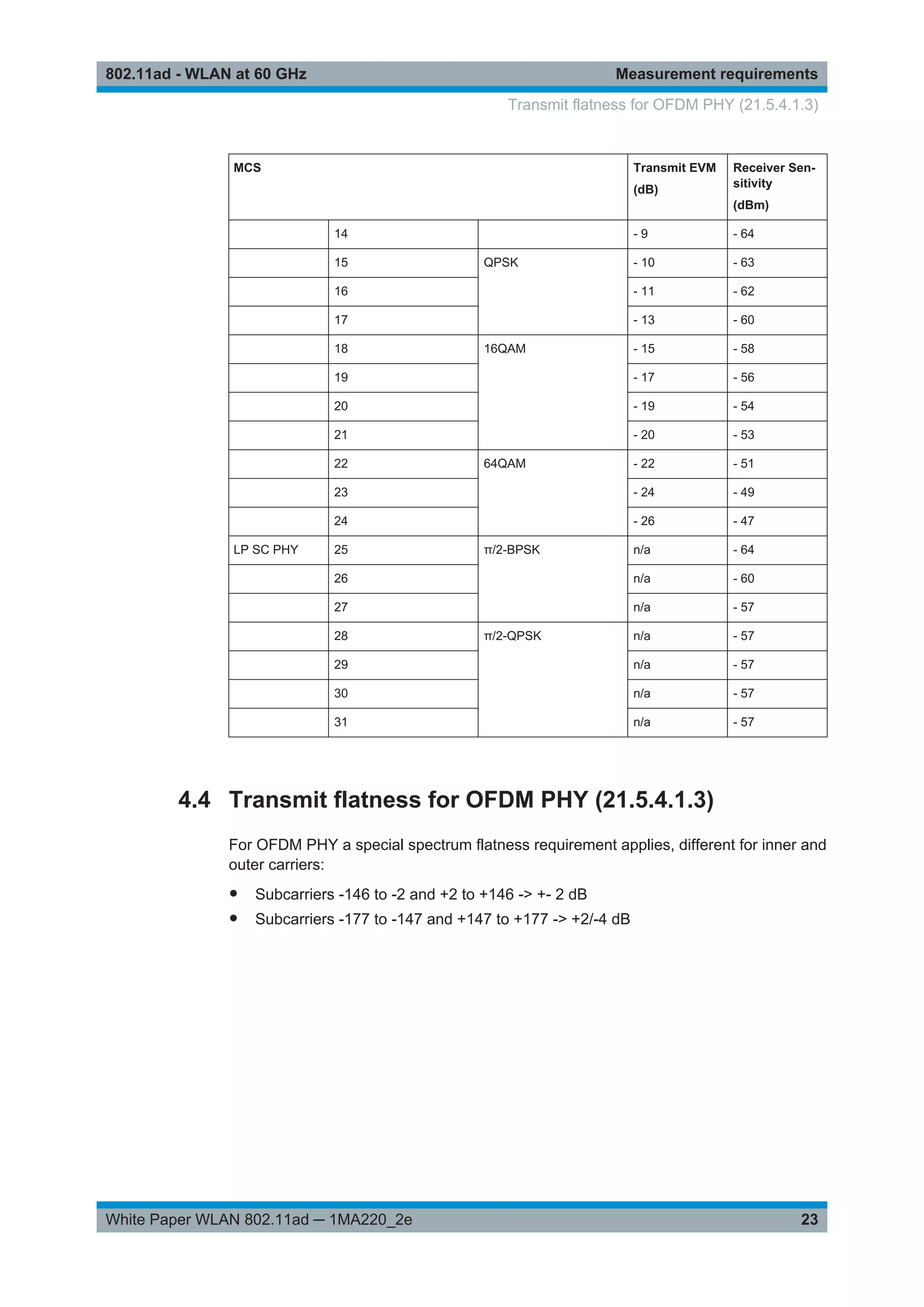
![Measurement requirements802.11ad - WLAN at 60 GHz
24White Paper WLAN 802.11ad ─ 1MA220_2e
Figure 4-2: Graphical summary of the requirements for TX flatness; the requirements are relaxed
starting with carrier 147.
4.5 Received channel power indicator (RCPI) measure-
ment (21.3.10)
The RCPI indicates the received RF power by a value in the range 0..255 in the power
range 0 dBm….-110 dBm in 0.5 dB steps. For more details see [1]. The RCPI differ-
ence to the actual power shall be at maximum ± 5 dB.
Received channel power indicator (RCPI) measurement (21.3.10)](https://image.slidesharecdn.com/1ma2202ewlan11adwp-170705105615/75/WLAN-at-60GHz-Whitepaper-from-R-S-1-ma220-2e_wlan_11ad_wp-24-2048.jpg)
![Appendix802.11ad - WLAN at 60 GHz
25White Paper WLAN 802.11ad ─ 1MA220_2e
5 Appendix
5.1 Golay sequences
In radiocommunications, training sequences are used for channel estimation. Prede-
fined sequences that are already known to the receiver are transmitted over the chan-
nel and evaluated by the receiver in order to estimate the channel. Complementary
Golay sequences are perfectly suited to this task because:
● the sum of the autocorrelation functions for two complementary Golay sequences
is ideal (lobes average out; see Figure 5-1)
● a Golay correlator is easy to implement
Figure 5-1: Examples for the ideal autocorrelation sum for a Golay sequence [2].
A Golay sequence is made up of bipolar (±1) symbols of the length n (Gn). A comple-
mentary sequence consisting of two sequences, each with a length of n, is identified as
Gan and Gbn, for example Ga128.
Figure 5-2: Example of a stage 3 Golay correlator; results in a length of n=8.
A fast correlator consists of the logarithm dualis of n blocks (i.e. seven blocks for
G128), that completes both correlations for a and b in parallel. For example, if the cor-
relator is fed with Gb sequences, peaks will appear at Output b.
In 11ad, sequences of varying lengths are used for different tasks (see [1] 21.11 for
sequences).
STF: G128. In this case the individual sequences are repeated, and a – sequence ter-
minates the STF.
● Control sends Gb128 first, followed by -Ga128
● All others send Ga128 first, followed by -Ga128
Golay sequences](https://image.slidesharecdn.com/1ma2202ewlan11adwp-170705105615/75/WLAN-at-60GHz-Whitepaper-from-R-S-1-ma220-2e_wlan_11ad_wp-25-2048.jpg)
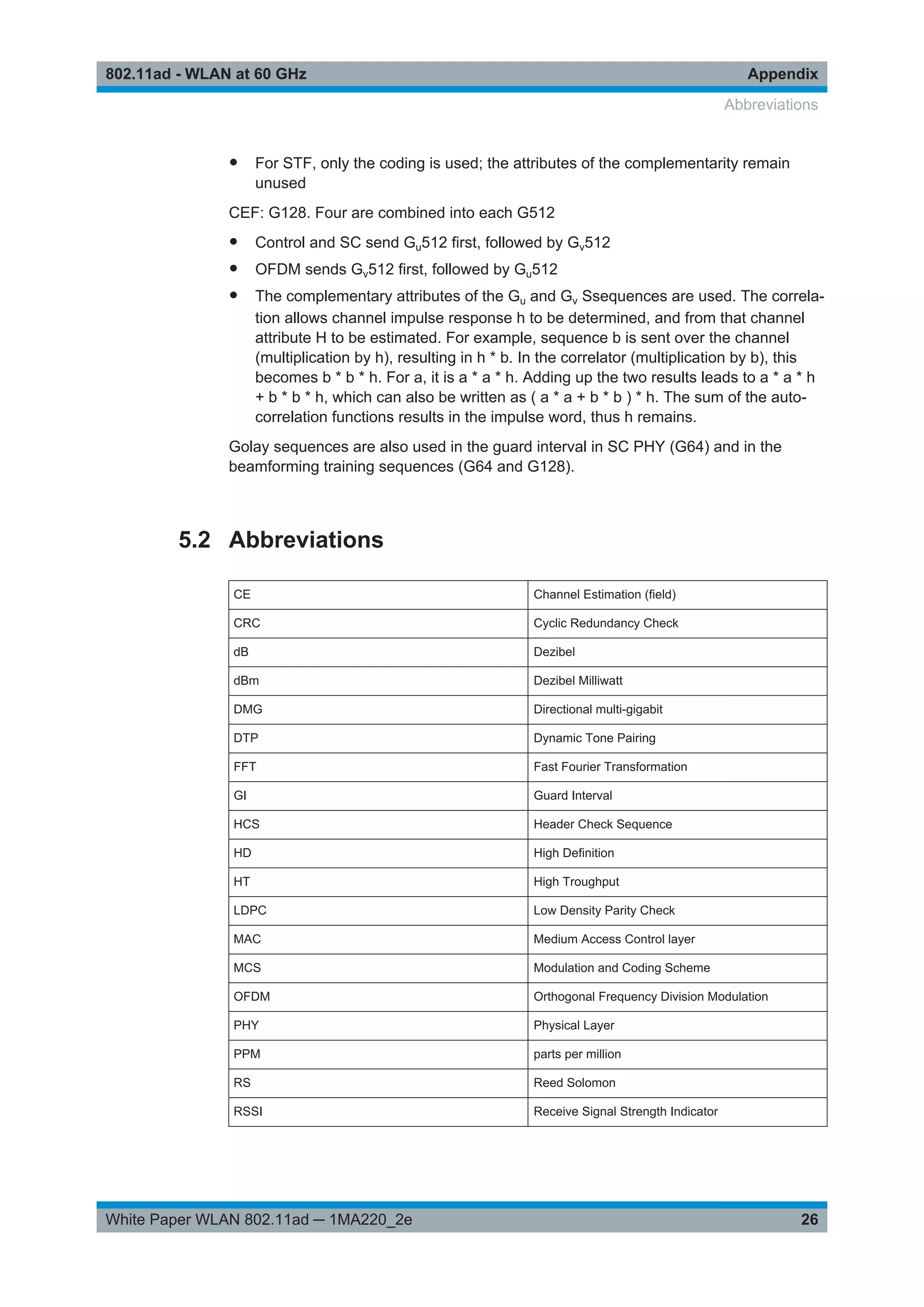
![Appendix802.11ad - WLAN at 60 GHz
27White Paper WLAN 802.11ad ─ 1MA220_2e
STF Short Training Field
STP Static Tone Pairing
TRN Training (field)
VHT Very High Troughput
WiGiG Wireless Gigabit Alliance
5.3 References
[1] IEEE: IEEE Std 802.11ad™-2012. Part 11: Wireless LAN Medium Access Control
(MAC) and Physical Layer (PHY) Specifications Amendment 3: Enhancements for
Very High Throughput in the 60 GHz Band
[2] Ming Lei and Ye Huang: CFR and SNR Estimation Based on Complementary Golay
Sequences for Single-Carrier Block Transmission in 60-GHz WPAN
References](https://image.slidesharecdn.com/1ma2202ewlan11adwp-170705105615/75/WLAN-at-60GHz-Whitepaper-from-R-S-1-ma220-2e_wlan_11ad_wp-27-2048.jpg)
